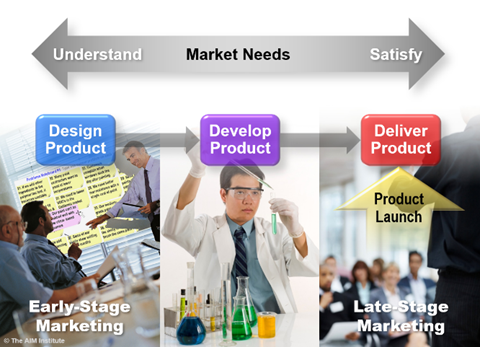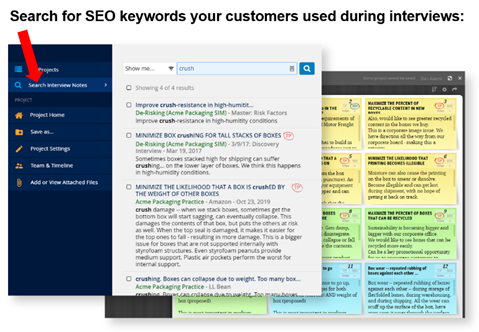10 Things you can do in the front-end for a better new product launch.
It’s common to think of three distinct product development stages…
- Front-end: This is where you design your new product, based on customer insight from New Product Blueprinting or other VOC. You can think of this as “early-stage marketing”… which sadly is often overlooked in favor of “late-stage marketing.”
- Development: Here your scientists, engineers or others go into the laboratory to develop your new product… a solution to the set of customer outcomes uncovered in the front-end.
- Launch: Now you deliver your new product to the market you targeted in the front-end. This product launch stage can be thought of as “late-stage marketing.”

Notice what should connect all three stages: market needs. There are many reasons for poor launch performance, but a primary cause is poor linkage with the front-end. Team either do lackluster front-end work—and therefore have little to connect to—or seem to forget their front-end work and “start fresh” with their launch planning. When you properly link your launch stage to the front-end work you did in New Product Blueprinting, you’ll apply these ten lessons:
- Same team: Use essentially the same team throughout the entire process. You’ll want marketing, technical and sales (at a minimum) represented in the front-end. As you begin your launch planning, you may wish to add a marketing communications (Marcomm) person, and an operations person.
- Start early: Begin your launch planning 10-12 months prior to the launch date, while still in the development stage. Keep your team focused on its front-end Market Case or Business Case as you begin planning your launch.
- Market definition: Rely heavily on what you learned in the front-end to know which companies should be included in your target market segment. Your Preference interview data may have revealed valuable information on how to further sub-segment your market… by geography, business model or point in the value chain. Be sure to use this in your launch.
- Use your outcomes: Your Blueprinting Market Case (or Business Case) included 10 customer outcomes, with hard data on how important and satisfied customers are with each. The outcomes you’re targeting with your new offering should be front-and-center in your launch messaging. Don’t fall back on product “features” when you have rich insight into these benefits.
- Target lead customers: In your front-end work, you probably found some companies more willing to work with you than others. Consider them as possible lead customers, to whom you might do an early or “soft” launch.
- Target decision-makers: As you set up and conducted Blueprinting interviews, you learned who the key decision-makers are within your target prospect companies. Use this intelligence as you decide which marketing channels to use in your launch campaign: For instance, will you promote in trade journals and shows attended by customer marketing… or technical functions?
- Target champions: Did you notice some individuals were particularly engaged when you interviewed them? When you launch your product, they could be “champions,” eager to tout your new product to colleagues. Be prepared to arm them with internal selling tools they can effortlessly use on your behalf.
- Inform your SEO: Today, the key to B2B launch success is often “findability.” For superior SEO (search engine optimization), you’d like to know the exact language prospects will use in a Google or Baidu search, right? Easy: Just data mine your Discovery interviews to see the specific terminology they used in your front-end interviews. To do this within your Blueprinter project, go to Menu > Search Interview Notes.

- Competitive testing: Did your team complete Blueprinting Step 4: Side-by-side testing? If you did, your work now has a “side-benefit” beyond helping you design your new product. Now you can tout hard data in your promotional work showing how your product is superior in outcomes that matter to the market.
- Pricing: The Blueprinting process encourages teams to uncover economic data during interviews and tours, which can then be used to build a value calculator. (See blueprintingcenter.com > BlueTools > Skill-Building & Others Tools > Value Calculator Examples.) Be sure to use this work to set a proper new-product price that won’t “leave money on the table.”
For more, download the AIM e-book, 12 Rules of B2B Product Launch, visit www.launchstar.com, and see executive video #21 at https://theaiminstitute.com/insights/video-series/.
Keywords: product launch, product commercialization, front end, LaunchStar, launch stage, SEO, search engine optimization, competitive testing, pricing, findability
